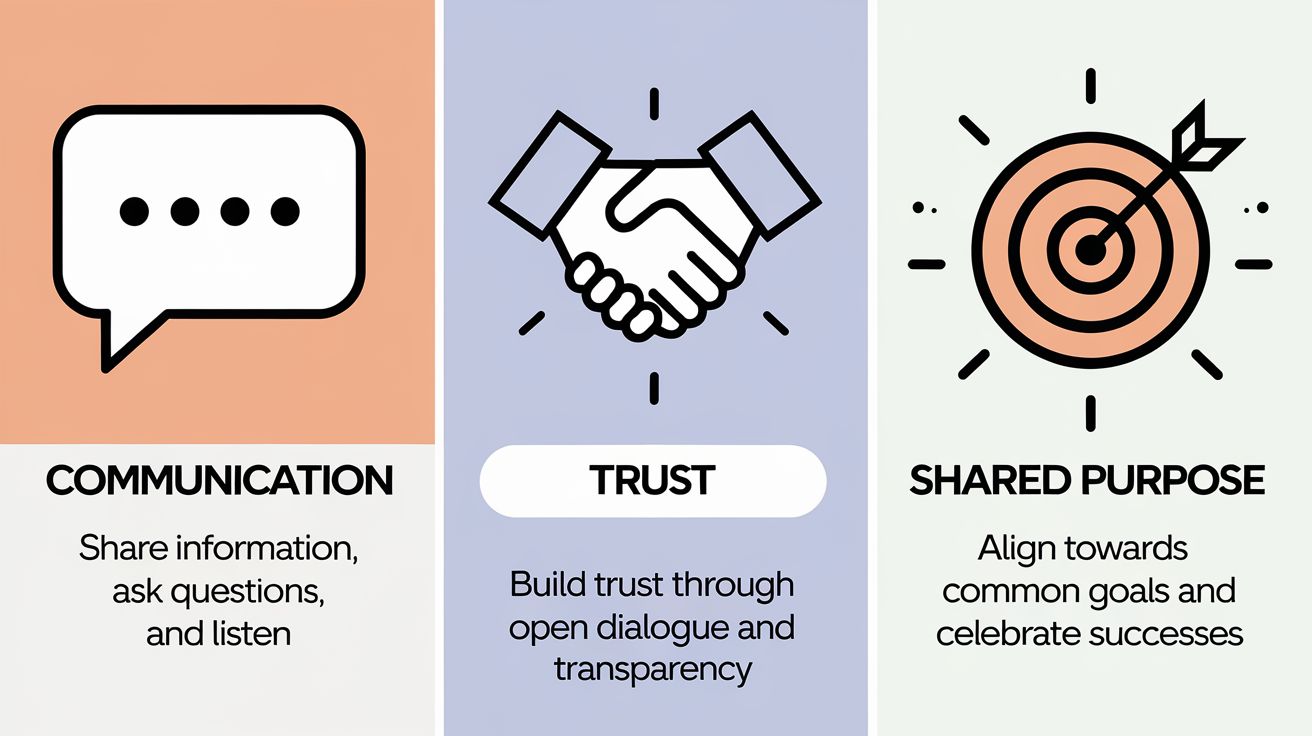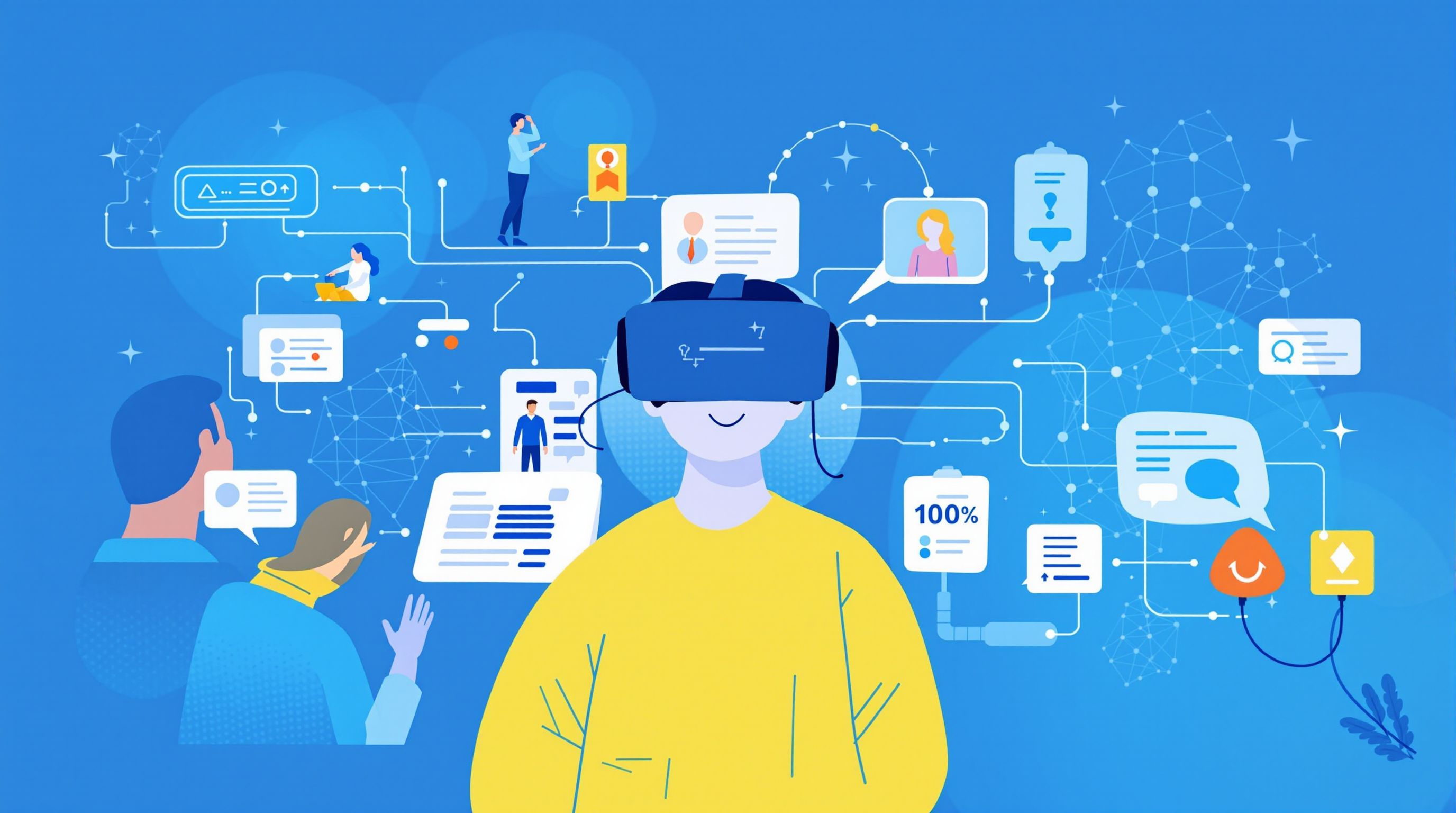In today's rapidly evolving work environment, workplace connections have become more crucial than ever. As organizations navigate hybrid work models and digital transformation, the ability to build and maintain meaningful relationships determines not just employee satisfaction, but overall business success. Let's explore how to create these vital bonds in the modern workplace.
Understanding the Modern Connected Workplace
The Three Pillars of Workplace Connection
The foundation of workplace connections rests on three essential pillars: communication, trust, and shared purpose. Communication forms the basic framework through which teams interact and share information. Trust creates the psychological safety needed for open dialogue and collaboration. Shared purpose aligns team members toward common goals, fostering unity and motivation.

Why Strong Connections Matter in 2025
Research shows that strong workplace connections directly impact productivity, innovation, and employee retention. When team members feel connected, they're more likely to share ideas, take calculated risks, and support each other through challenges. These high-quality connections in the workplace lead to increased job satisfaction and reduced burnout rates.
The Cost of Disconnected Teams
Organizations with disconnected teams face significant challenges. Low morale, decreased productivity, and higher turnover rates are just the beginning. Teams lacking strong social connections in the workplace often struggle with miscommunication, missed opportunities for collaboration, and reduced innovation potential.
Building Trust and Psychological Safety
Creating Safe Spaces for Open Dialogue
Establishing psychological safety begins with creating environments where team members feel comfortable expressing their thoughts and concerns. Leaders should encourage open communication by actively listening, responding constructively to feedback, and demonstrating that all perspectives are valued.
Setting Clear Team Expectations
Clear expectations provide the framework for building connections in the workplace. Teams need to understand both their individual roles and how they contribute to collective success. This clarity helps prevent misunderstandings and creates a foundation for stronger relationships.
Embracing Vulnerability in Leadership
Leaders who show vulnerability help create authentic workplace connections. By sharing their own challenges and learning experiences, leaders demonstrate that it's safe for others to do the same.
Fostering Meaningful Workplace Connections
Implementing Cross-functional Collaboration
Cross-functional collaboration breaks down silos and creates opportunities for making connections in the workplace. When teams from different departments work together, they gain new perspectives and build relationships that extend beyond their immediate work groups.
Organizing Team Building Activities
Structured team building activities provide opportunities for colleagues to interact in different contexts. These activities should balance fun with purpose, creating shared experiences that strengthen workplace bonds. Virtual team building has become equally important for remote workers.

Facilitating Informal Social Interactions
Informal interactions are vital for building authentic relationships. Creating spaces and opportunities for casual conversations, whether physical or virtual, helps team members connect on a personal level and develop stronger professional relationships.
Leveraging Technology for Connection
Digital Tools for Remote Team Bonding
Modern technology offers numerous solutions for maintaining workplace connections in remote and hybrid settings. Video conferencing, collaboration platforms, and digital workspace tools help bridge the physical distance between team members.
Virtual Communication Best Practices
Effective virtual communication requires intentional effort and clear guidelines. Teams should establish norms for digital interaction, including response times, preferred communication channels, and meeting protocols. This structure helps maintain connection while preventing digital fatigue.
Creating Digital Community Spaces
Online community spaces provide venues for both work-related discussions and social interaction. These digital environments should be designed to encourage participation, share knowledge, and foster a sense of belonging among team members, regardless of their physical location.
The landscape of workplace connections continues to evolve as organizations adapt to new ways of working. By focusing on building strong relationships, fostering trust, and leveraging appropriate technology, teams can create meaningful connections that drive success and satisfaction in the modern workplace.
Promoting Diversity and Inclusive Connections
Building meaningful workplace connections requires embracing diversity and fostering an inclusive environment where every employee feels valued and heard. Organizations that prioritize diverse connections see improved innovation, better problem-solving, and stronger team cohesion. Let's explore how companies can create more inclusive spaces for authentic workplace connections to flourish.
Implementing Employee Benefits Programs
A well-designed employee benefits program plays a crucial role in fostering workplace connections. Modern platforms like Neroia go beyond traditional benefits by using AI-driven technology to facilitate natural social interactions through shared interests in sports, wellness, and cultural activities. These platforms help break down departmental barriers and create organic opportunities for colleagues to connect over common passions.
When implementing such programs, organizations should focus on solutions that encourage spontaneous interactions and genuine relationship-building. The key is selecting platforms that align with company culture while providing employees the flexibility to engage in ways that feel natural and meaningful to them.
Creating Employee Resource Groups
Employee Resource Groups (ERGs)
Employee Resource Groups serve as powerful catalysts for building high quality connections in the workplace. These voluntary, employee-led groups bring together individuals who share common characteristics, experiences, or interests. ERGs create safe spaces where employees can connect authentically while contributing to the organization's goals.
For example, a women in technology ERG might organize mentorship programs, professional development workshops, and networking events. These groups help members develop leadership skills while fostering connections across departments and hierarchical levels. The key is ensuring ERGs receive proper support, resources, and recognition from leadership to maximize their impact on workplace culture.
Implementing Inclusive Communication Policies
Clear communication guidelines help create an environment where diverse perspectives are welcomed and valued. Organizations should establish policies that promote respectful dialogue and ensure everyone has opportunities to contribute. This includes addressing unconscious bias, encouraging active listening, and providing multiple channels for feedback and discussion.
Simple practices like rotating meeting facilitators, implementing "round-robin" participation, and creating structured opportunities for quieter voices to be heard can make a significant difference. Additionally, organizations should consider language accessibility, providing materials in multiple formats, and ensuring digital tools are accessible to all employees.
Supporting Cross-cultural Understanding
Making connections in the workplace becomes more meaningful when employees understand and appreciate different cultural perspectives. Organizations can promote cross-cultural understanding through educational programs, cultural celebration events, and structured learning opportunities.
Regular cultural awareness workshops, international lunch-and-learn sessions, and cross-cultural mentoring programs help break down barriers and build bridges between different groups. These initiatives should focus on practical applications, helping employees develop skills for effective cross-cultural communication and collaboration.
Measuring Connection Success
Understanding the impact of workplace connection initiatives requires systematic measurement and evaluation. Organizations need clear metrics to assess the effectiveness of their efforts and make data-driven improvements to their connection strategies.
Key Performance Indicators
Successful social connections in the workplace can be measured through various indicators. Employee engagement surveys, participation rates in connection-building activities, and retention statistics provide valuable insights. Organizations should track both quantitative metrics (like attendance at social events) and qualitative feedback (such as employee satisfaction with connection opportunities).
Network analysis tools can map informal relationships and communication patterns, helping identify areas where connections need strengthening. Regular pulse surveys can gauge the quality of workplace relationships and highlight potential areas for improvement.
Employee Feedback Methods
Gathering honest feedback about workplace connections requires multiple channels and approaches. Anonymous surveys, focus groups, and one-on-one discussions help create a comprehensive picture of how employees experience connection opportunities.
Regular check-ins, suggestion boxes, and digital feedback platforms allow organizations to collect ongoing input about what's working and what needs adjustment. The key is creating safe spaces for honest feedback and demonstrating that employee input leads to meaningful changes.
Adjusting Strategies Based on Data
Data collection is only valuable when it informs action. Organizations should regularly review connection metrics and feedback to refine their approaches. This might involve adjusting event formats, changing communication channels, or redesigning connection programs based on employee preferences and participation patterns.
Future of Workplace Connections
The landscape of workplace connections continues to evolve with technological advances and changing work patterns. Understanding emerging trends helps organizations prepare for future challenges and opportunities in building meaningful workplace relationships.
Emerging Trends in Team Building
Virtual reality meetups, gamified connection platforms, and AI-powered matching systems are reshaping how colleagues build relationships. These technologies create new opportunities for workplace connections while maintaining the human element essential for authentic relationships.
Organizations are moving away from traditional team-building exercises toward more organic, interest-based connections. This shift recognizes that genuine relationships often form around shared interests and natural interactions rather than forced activities.

Adapting to Hybrid Work Models
As hybrid work becomes the norm, organizations must innovate to maintain strong workplace connections across physical and virtual spaces. This includes developing new strategies for inclusive meetings, social events, and casual interactions that work equally well for remote and in-person participants.
Successful hybrid connections require intentional planning and technology integration. Organizations need to create equal opportunities for connection regardless of work location while avoiding the creation of two-tier workplace cultures.
Innovation in Connection Technology
The future of workplace connections will be shaped by technological innovations that make it easier for employees to find and build meaningful relationships with colleagues. From AI-powered networking tools to virtual water cooler spaces, technology will continue to evolve to support authentic workplace connections.
The future of workplace connections lies in embracing innovative technologies that enhance human relationships rather than replace them. Organizations seeking to strengthen their social fabric can benefit from modern employee benefits platforms that prioritize authentic connections. For instance, Neroia's AI-driven platform transforms how colleagues interact by facilitating natural micro-gatherings around shared interests in sports, wellness, and cultural activities. This approach moves away from traditional forced networking events, instead creating an environment where meaningful relationships develop organically, leading to stronger team bonds and a more engaged workforce.


